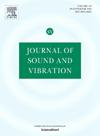Dynamic modeling and spectrum modulation effect of multi-type bearing-supported rotor systems with combined misalignment faults
IF 4.3
2区 工程技术
Q1 ACOUSTICS
引用次数: 0
Abstract
Multi-type bearing-supported rotor (MBR) systems leverage versatile bearing configurations to achieve broad applicability across industrial sectors. Inadequate assembly capabilities leading to pedestal-raceway misalignment will inevitably trigger operational hazards to the MBR system. In this regard, this paper develops a flexible model of the MBR system incorporating novel combined misalignment configurations. The dynamic analytical stiffness matrix for multi-type bearings has been derived based on implicit functions and the chain rule of differentiation. The bending-torsional coupling effect of the flexible MBR system is faithfully reproduced by combining the derived dynamic analytical stiffness with the Timoshenko beam theory. The frequency-capturing capabilities of the proposed model have been validated through a comprehensive comparison between theoretical, experimental, and developed models. Additionally, qualitative and quantitative comparisons are conducted between the healthy, static misalignment, dynamic misalignment, and combined misalignment modes from the perspectives of motion characteristics, time domain, and frequency domain. Vibration intensity and energy transfer analyses reveal distinct amplification and cancellation effects in combined misalignment scenarios. Systematic analysis identifies the characteristic frequencies and distinct mutual modulation effects inherent to combined misalignment. Additionally, the compensation mechanism of combined misalignment modes with multi-type bearing clearances has been revealed.

求助全文
约1分钟内获得全文
求助全文
来源期刊

Journal of Sound and Vibration
工程技术-工程:机械
CiteScore
9.10
自引率
10.60%
发文量
551
审稿时长
69 days
期刊介绍:
The Journal of Sound and Vibration (JSV) is an independent journal devoted to the prompt publication of original papers, both theoretical and experimental, that provide new information on any aspect of sound or vibration. There is an emphasis on fundamental work that has potential for practical application.
JSV was founded and operates on the premise that the subject of sound and vibration requires a journal that publishes papers of a high technical standard across the various subdisciplines, thus facilitating awareness of techniques and discoveries in one area that may be applicable in others.
 求助内容:
求助内容: 应助结果提醒方式:
应助结果提醒方式:


